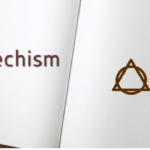Over the past several years, I cannot begin to number the times I have responded or interacted with the Calvinist argument that the new creation in Christ was made through a secret regeneration that preceded faith, repentance and the baptism into Christ accompanied by that rising as a new creation to walk in newness of life. The scriptures cry out for a rebuttal of the Calvinist error. The Gospel intended for a lost and hurting world demands it. Yet, the insistence on the part of Calvinists continues with its purely aberrant doctrine.
There is a convinced segment of Christians who truly believe that they were secretly born again without any evidence of faith in the person and work of Jesus Christ. I suppose such souls could come to that imperfection through a variety of sources but most seem to arrive there because they have been taught by pastors who have been taught by other pastors, many of whom base much of their beliefs on whatever the latest internet teacher has to say on the matter.
The “young, restless reformed” of the Calvinist churches glean much of what they believe specifically from internet resources and few of them have ever cracked the spine of any original source book or document. If there is one in a hundred Calvinists who have ever read much of John Calvin’s Institutes, I would be surprised. Now to be fair, there are a lot of Arminians who have not read Arminius, much of Wesley or any of the major non-Calvinist theologians over the years. I have tried to take another approach with my understanding of these matters by reading as much of the “opposition” as possible and that brings me to my selection here. This topic came up again as expected and I thought it might be best to keep a reference to this matter here on this Introspection.
John Calvin wrote a lot of stuff. Seriously, a lot of stuff, and it would take a life time or more to digest it all. A lot of it is really good and some of it is, well, pretty confused. However, I think his confusion pales in comparison to the confusion of those who followed in his doctrines. The idea of men being regenerated prior to faith and repentance does not sit well with what Calvin specifically taught regarding the matter. In fact, Calvin’s teaching on this matter, as shown below, is very similar to what a Reformed Arminian or General Baptist might agree with.
Of course the young, restless, reformed follower might reply that he doesn’t follow Calvin, to which I might suggest he stop following any number of internet hatchet sites as well. The following is taken from Calvin’s Institutes and demonstrates that he was of the opinion that regeneration does not precede faith and repentance (there might be conflicting statements elsewhere, although such would confirm Calvin’s own confusion). Instead regeneration is defined by repentance that, earlier in this book, Calvin states follows faith (III, ch 3,i) — something to keep handy, as you never know when the next assertion of the neo-Calvinist error will be made.
- Both of these (faith and repentance) we obtain by union with Christ. For if we have true fellowship in his death, our old man is crucified by his power, and the body of sin becomes dead, so that the corruption of our original nature is never again in full vigor. If we are partakers in his resurrection, we are raised up by means of it to newness of life, which conforms us to the righteousness of God.
In one word, then, by repentance I understand regeneration (spiritual regeneration) , the only aim of which is to form in us anew the image of God, which was sullied, and all but effaced by the transgression of Adam.
- So the Apostle teaches when he says, “We all with open face beholding as in a glass the glory of the Lord, are changed into the same image from glory to glory, as by the Spirit of the Lord.”
Again, “Be renewed in the spirit of your minds” and “put ye on the new man, which after God is created in righteousness and true holiness.” Again, “Put ye on the new man, which is renewed in knowledge after the image of him that created him. Accordingly through the blessing of Christ we are renewed by that regeneration into the righteousness of God from which we had fallen through Adam, the Lord being pleased in this manner to restore the integrity of all whom he appoints to the inheritance of life. This renewal, indeed, is not accomplished in a moment, a day, or a year, but by uninterrupted, sometimes even by slow progress God abolishes the remains of carnal corruption in his elect, cleanses them from pollution, and consecrates them as his temples, restoring all their inclinations to real purity, so that during their whole lives they may practice repentance, and know that death is the only termination to this warfare.
The greater is the effrontery of an impure raver and apostate, named Staphylus, who pretends that I confound the condition of the present life with the celestial glory, when, after Paul, I make the image of God to consist in righteousness and true holiness; as if in every definition it were not necessary to take the thing defined in its integrity and perfection. It is not denied that there is room for improvement; but what I maintain is, that the nearer any one approaches in resemblance to God, the more does the image of God appear in him. That believers may attain to it, God assigns repentance as the goal towards which they must keep running during the whole course of their lives.
– Institutes of the Christian Religion, Book III, ch 3, ix.






Leave a Reply